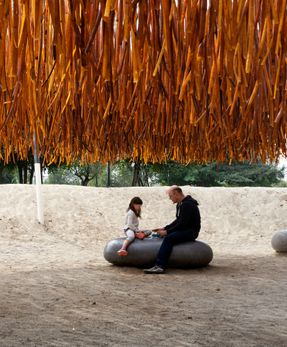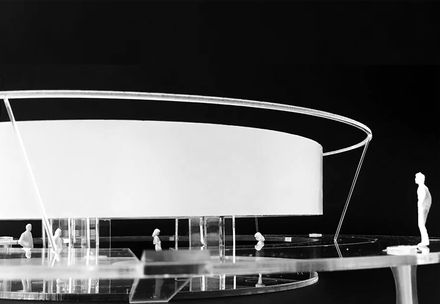
Pavilion Yap Constructo 8 La Luz del Cochayuyo
ARCHITECTS
Domingo Arancibia Tagle
LEAD ARCHITECT
Domingo Arancibia, Andres Peña
MANUFACTURERS
Autodesk, Baskakow, Fijaciones Mamut, Istria Maestranza, Robert Mcneel & Associates, Seaweed Place Chile, Vanghar Mobiliario Urbano
CONSULTS
Istria Maestranza, Mamut Fijaciones, Seaweedplace Chile - Cochayuyos
DESIGN TEAM
Domingo Arancibia, Andres Peña, Mauricio Lacrampette, Soledad Fernandez, Valentina Verdugo, Javiera Gonzalez, Martin Busel, Amaro Donoso, Matias Carvajal, Stephan Puschel, Ignacio Gonzalez
COLLABORATORS
Alliende Sebastian, Araneda Consuelo, Arrau Felipe, Braga Monica, Bustos Jose-fina, Chaperon Walter, Carvajal Matias, Cortes Pablo, Cox Agustina, Donoso Amaro, Elicer Ja-viera, Farias Josefa, Fernandez Armando, Guzman Sofia, Gonzalez Camilo, Gonzalez Roberto, Hernandez Fabian, Ibañez Sebastián, Jadue Damian, Jerez Gohan, Machuca Diego, Madrid Montserrat, Machuca Amanda, Mattei Renata, Morales Elly, Mohr Victoria, Parra Elias, Puschel Stephan, Pinochet Sofia, Quinteros Alexis, Quinteros Leonardo, Retamal Martín, Rodriguez Pao-la, Sandoval Felipe, Sanhueza Jorge, Santillan Antonia, Zamorano Bernardita
ENGINEERING
Alving Ingenieros / www.alving.cl
AREA
254 M²
YEAR
2019
LOCATION
Las Condes, Chile
CATEGORY
Installations & Structures
Text description provided by architect.
A contest carried out by Constructo and sponsored by the MoMA of New York.
The project has continued for more than 8 years in Chile and seeks to allow the creation of temporary interventions by young architects in the Araucano Park, belonging to the Municipality of Las Condes, during a period of about six weeks.
Many times we overlook materials that have always accompanied us, and that have acted as forgers of our imagination, culture and identity. We began by investigating its characteristics: its length, plasticity, colour and texture were some of the peculiarities that we found.
However, we were surprised to discover a strange and unexpected phenomenon: its ability to illuminate by the impact of the sun's rays, thanks to its translucent material.
Without major pretensions regarding the aesthetic result, we wanted to somehow show a crude project, a construction without much detail, highlighting and valuing the force of the movements of the earth and the mass created by a volume of thousands of hanging cochayuyos.
We proposed to provide a kind of shelter in the park creating a limit that will achieve the status of refuge. In this way, we modified the topography of the place, burying ourselves about one meter below ground level.
With the surplus land we built a slope, in order to have the feeling of being half a level below ground. Thus, we created a crater which aimed to isolate itself from the immediate context, making the relationship between the visitor and the cochayuyos more dramatic.
Inside this crater, we seek to carry out a neutral space, a buried plaza that served for various acts and children's games which we equipped with only three monolithic pieces for seating and contemplation of the space.
To achieve the volume we hung 12,000 pieces of cochayuyos, each 12 cm apart, in order to create a suspended body by summation.
One of the difficulties that the project faced was the fragility of the cochayuyos, since they become fragile once they lose water.
That is why our design strategy from the very start was defined as to create a suspended body by hanging the pieces so that the visitor could not be in direct reach of the seaweed. For this, we had to propose a two-month-long process.
To support the four tons that the 12,000 pieces of cochayuyos weighted when absorbing water, a structure based on a perimeter steel ring of 18 meters in diameter with a 250x120 cm section supported by 6 pillars of 12.5 mm was proposed.
As a system for hanging the pieces, we proposed a tensioner system that created a 3x3-meter reticulated mesh which transmitted all the load to the ring.
At the same time, a 0.9 mm nylon net was installed on it so as to have a smaller grid where the cochayuyos could hang.
We discovered that a phenomenon of light scattering occurs in the cochayuyo, which means that the seaweed "lights up" naturally when exposed to sunlight due to its translucency and morphology.
The intervention was inserted in the park not only as a specific space but it also sought to be present in the collective memory of all Chilean visitors, who in some way have been related to the Cochayuyo.
Like the lampshade of a lamp, the cochayuyo works as a receiver and diffuser of light waves. Faced with this property, the project proposed two types of lighting, one natural and the other artificial, which in turn provided different atmospheres.
The steel structure which we intentionally left uncoated rusted over the entire duration of the existence of the pavilion, which was desirable by the team.
As for the cochayuyos, they were changing and modifying their morphology during the month and a half that they were in the park.
We discovered that the different pieces moved according to the sun: like a sunflower, the hanging seaweed was rotating in search of natural light.
Throughout the existence of the pavilion, the seaweed was curling, breaking and changing its shape from the first day until its disassembly, giving the project a dynamics of time that we found to be of interest.
In this way we celebrate the death of the piece, seeking to highlight the passage of time and its impact on the pavilion, which was presented as a “living body” that had to face its end.
The structure of the project was handed over to the sports foundation Deporte Libre and is currently a sports plaza in the commune of Renca.
As for the cochayuyo pieces, these were donated as fertilizer, some as food for the park workers and others for various studies on the algae which are under development.




























